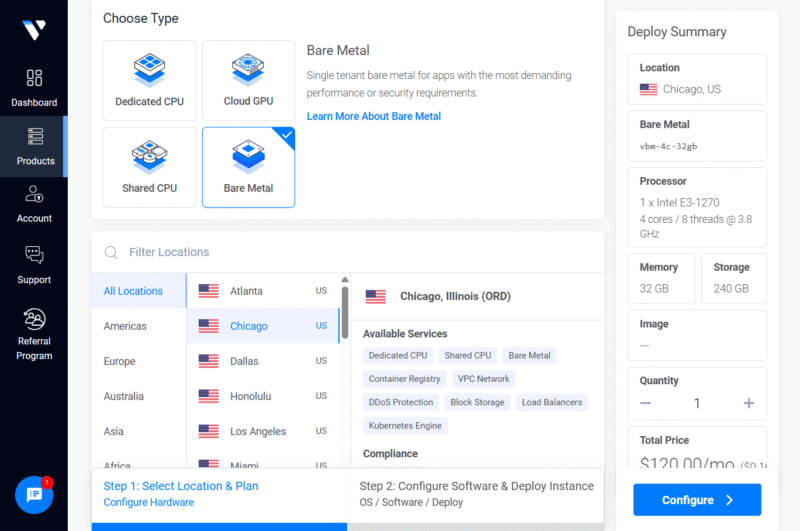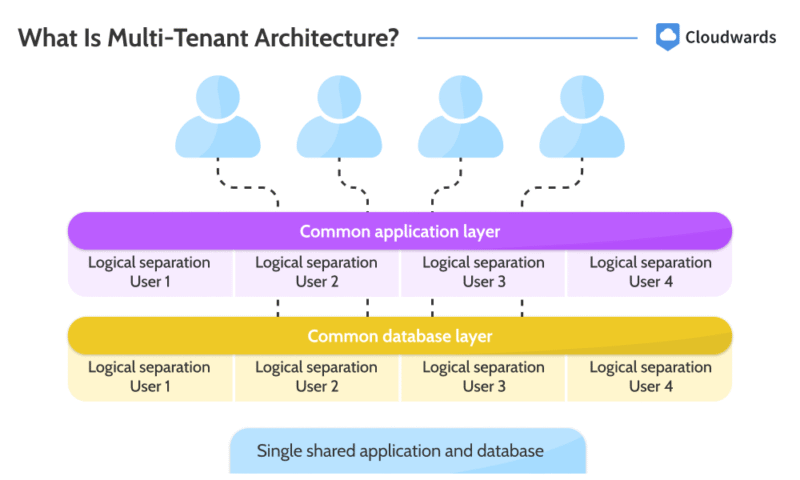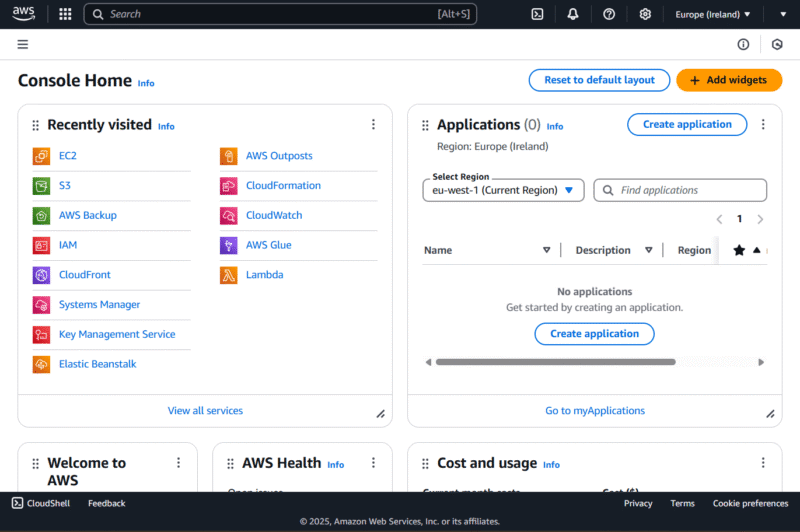Cloud computing platforms achieve economies of scale in the cloud by sharing their resources among multiple customers. Nevertheless, having multiple tenants share cloud infrastructure comes with some downsides, which are absent when resources are dedicated to one customer.
Depending on the tenancy model, cloud resources can be either single-tenant (dedicated) or multi-tenant (shared). In addition to being shared or unshared, each model has different characteristics that influence their most fitting use cases. Read on as we explore the differences and implementations of single-tenant vs multi-tenant cloud architecture.
What Is Single-Tenant Architecture?
Single-tenant architecture is a model that involves cloud resources dedicated to one entity, such as an individual or an organization. It is available on both public and private cloud deployment models but is more common with private cloud.
Infrastructure as a Service (IaaS), Platform as a Service (PaaS) and Software as a Service (SaaS) can be single-tenant.

A single-tenant environment is like a single-family home, where resources are dedicated to one family but the bills are higher.
Since single-tenant cloud architecture is dedicated to one user, it offers isolation, and with that comes enhanced security. In addition, it allows a high degree of customization and comes with improved performance since all the computing power is available to one user. That said, single tenancy is expensive.
Single-Tenant System Examples
Examples of a single-tenant system include bare-metal servers on public clouds like IBM Cloud, DigitalOcean and Vultr, as well as SaaS solutions like Microsoft 365, ServiceNow and BMC Helix ITSM.

Vultr bare-metal servers allow you to run performance-sensitive workloads
without the noisy neighbor effect.
What Is Multi-Tenant Architecture?
Multi-tenant architecture is a tenancy model in which multiple users share a single software instance or the same underlying cloud resources. It is the most common tenancy model in the cloud, particularly public cloud environments, and it favors economies of scale. It is available for IaaS, PaaS, SaaS and other delivery models.

Multi-tenant environments are like apartment complexes, where the bills are lower but you share building resources with neighbors.
In multi-tenant cloud architecture, computing power is shared; therefore, performance may not always be at its peak for each user. In addition, customization is limited and there’s less isolation, which raises security concerns. Nonetheless, the multi-tenant model is often cheaper than the single-tenant model.
Multi-Tenant System Examples
Cloud services like AWS, Azure, Netflix, Gmail and Slack are multi-tenant solutions, but many of them implement robust security to mitigate risks.

AWS serves multiple users within virtually isolated environments.
Multi-Tenant vs Single-Tenant: What’s the Difference?
The primary difference between multi-tenant and single-tenant solutions is resource dedication. However, they also differ in cost, customization, performance, security and scalability.
| Feature: | Single-Tenant | Multi-Tenant |
|---|---|---|
| Resources | Dedicated infrastructure | Shared infrastructure |
| Cost | More expensive | Less expensive due to the scale effect |
| Customization | Allows more control and a deeper level of customization |
Allows more control and a deeper level of customization |
| Performance | Performance is more consistent | Performance can be influenced by other tenants sharing the resources |
| Configuration | Offers more control and customization but requires more configuration | Relatively easier to configure |
| Isolation | Offers physical isolation | Offers logical isolation |
| Security | Since resources are physically isolated, it offers more security | ogical isolation isn’t foolproof, so security is dependent on measures the cloud provider takes |
| Scalability | Cannot scale as fast as multi-tenant resources | Scales faster than single-tenant resources |
What Is Mixed Tenancy?
Mixed tenancy is a hybrid of single-tenant and multi-tenant systems. Instead of the dualism of being either dedicated or shared, mixed tenancy involves dedicating some resources to single users and sharing other resources with multiple users.
For instance, rather than have all of your workloads run on dedicated resources, in mixed-tenancy you could have sensitive workloads on single-tenant resources while non-sensitive workloads stay on multi-tenant resources.
Mixed-tenancy offers the best of single- and multi-tenant systems, offering enhanced security, performance and control while ensuring you maintain cost-efficiency.
Single-Tenant vs Multi-Tenant: Use Cases
The most recurring themes in single-tenant use cases are security and control, while in multi-tenant use cases, the goals are typically cost-efficiency and scalability.
When Is Single-Tenant Useful?
The single-tenant model is useful when you want enhanced security and control, such as when deploying workloads involving healthcare data, financial data or government data. Single tenancy also comes in handy when running performance-sensitive workloads, including real-time analytics and scientific computations.
When Is Multi-Tenant Useful?
Since they can readily scale up or down, multi-tenant systems are useful when running workloads that serve a massive number of end users, including SaaS solutions like email services and customer resource management.
To ensure cost-efficiency for both the cloud provider and the customer, multi-tenancy is useful in public cloud environments. With many users sharing the underlying IaaS and PaaS resources, cloud providers can make more profit per unit and charge users lower rates.
Single-Tenancy Environment Pros & Cons
Single-tenancy environments offer more security, control and performance, but they cost more and require more effort to set up.
Benefits
- Enhanced security: In single-tenant environments, your resources are physically isolated from other people’s resources. Therefore, the risks of a data breach are much lower.
- Control: Since the supporting infrastructure is reserved for you, you have total control over it and can customize it as desired.
- Consistent performance: Single-tenant environments are unshared, so their performance is more predictable and consistent.
- Compliance: A single-tenant environment can help you meet compliance requirements in industries such as finance and healthcare.
- Consistent configuration: Some multi-tenant models have to modify the code or data structure for each user, which can be complex. In single-tenant clouds, you have just one environment and configuration is consistent throughout.
Challenges
- Configuration burden: In a multi-tenant cloud, cloud providers typically handle the bulk of the configuration, designing the environment to be suitable for each user. Conversely, in a single-tenant cloud, you have more configuration responsibility.
- Inflexible scalability: Single-tenant architecture requires the deployment of physical hardware, so scaling up or down — though possible — isn’t as fast or flexible as with multi-tenant architecture.
- Higher costs: There are no economies of scale with single tenancy, so the cloud provider will charge you higher rates.
Multi-Tenancy Environment Pros & Cons
When in a multi-tenant environment, you’ll pay lower rates and scale faster. However, there’s less isolation and control.
Benefits
- Lower rates: In multi-tenant environments, the cloud provider offers each user lower rates because it earns more in total for each resource unit it rents out.
- Scalability: Multi-tenant environments offer virtual resources, which have fewer infrastructure implications when you provision and de-provision them as your needs change. Therefore, they are highly scalable.
- Less configuration: When running workloads in a multi-tenant environment, you have to worry only about configuring your assigned virtual environment and user management for your own customers. The cloud provider handles the configuration of the physical resources.
- Reduced overhead: Multi-tenant environments come with lower management costs because you pay lower rates and spend less on labor to configure your resources.
- Efficient resource usage: In a multi-tenant cloud, resources are often used to their fullest and are less likely to be underutilized.
Challenges
- Security: In a multi-tenant environment, your resources are logically isolated from your neighbor’s. However, this isolation is not infallible, and security is mostly dependent on the cloud provider’s configuration.
- Limited control: In a multi-cloud environment, your control extends only to the virtual space assigned to you. Therefore, your options for customizing your resources are very limited.
- Potential performance issues: Tenants sharing the same supporting infrastructure typically don’t have the same usage patterns, so the resources can usually handle them without performance issues. However, at maximum resource usage, usage patterns can influence each other. For this reason, multi-tenant architecture is prone to performance issues.
Final Thoughts: Single-Tenant vs Multi-Tenant
Even though single-tenant architecture gives you more control, performance and security, it does so at higher rates and at the expense of scalability. Multi-tenant environments, on the other hand, retain scalability and lower rates but cannot offer the consistency and control of single-tenant environments.
Therefore, whenever possible, it’s best to opt for a mixed-tenant environment to get the best of both worlds.
Do you use any services that you didn’t realize are multi-tenant? Which customizations are you limited from making on the service? Share your experience with multi-tenant and single-tenant services with us in the comments below. As always, thank you for reading.
FAQ: Single-Tenant & Multi-Tenant Architecture in Cloud Computing
-
The primary differences between single-tenant and multi-tenant solutions are isolation and resource dedication. Single-tenant systems are physically isolated and have dedicated resources, while multi-tenant clouds are logically isolated and run on shared resources.
-
The disadvantages of multi-tenancy architecture include limited control, variable performance and security risks.
-
Examples of multi-tenant applications include Gmail, Zendesk, Outlook, AWS, Google Cloud, Azure, Prime Video and Netflix.








